
DOWNLOAD
DATE
Contact
The wind of change is blowing strongly in transportation & logistics. Digitization is in full swing: it is opening a whole portfolio of new opportunities to reduce costs, differentiate product offerings and redefine business models. Digital freight platforms are driving the transformation. The narrow focus on clearly delineated market segments currently restricts their disruption potential. However, the longterm effect on the industry can be immense, as other sectors have shown.
Various players have entered the race for tomorrow’s leading market position in transportation & logistics. Digital innovators were at the forefront of this development, and now established providers are in reaction mode. Some joined the race early on, some joined later, and others are still evaluating how to play in this new field. Few providers have embedded their actions into coherent, wellconceived digital game plans. Many are adopting “me-too” strategies. Launching yet another digital freight exchange will not do it for established players. Others have already advanced significantly on the learning curve, and the industry is swamped with digital platforms by now. At the same time, M&A and cooperation options are limited: established players have already acquired or entered alliances with the most promising new entrants.
Strategic options for logistics service providers are fading. The race is wide open for everyone, but digital players are driving the change currently. Will new platforms reshape the industry? Possibly… Does this mean “game over” for traditional service providers? Not at all… Established players can build upon long industry experience, strong brand power and broad value-chain coverage to develop their future unique selling points. Digital pioneers, on the other hand, bring in cutting-edge technology, smart problem solving and agile structures to take on the fight.
Even though logistics service providers have lost their leading edge in certain areas, they continue to be in a strong position to come out as one of the few winners in this race. One thing is for sure: consequent action is required to sail with the wind towards the safe shores and avoid declining into a niche position.
1. Digital platforms are on the rise
New business models challenge the status quo in the industry
The transportation & logistics industry is changing. Technological improvements provide market players with the unique chance to catapult their business models from “manual, expensive and stiff” to “automated, efficient and agile”. Companies can benefit in three ways from the new opportunities that digitization has to offer, as Figure 1 depicts.
First, new technologies enable market players to increase efficiency in operations and administrative functions. Some examples: smart robots cut logistics costs by 20 percent at Amazon, augmented reality lowers picking errors by up to 25 percent in DHL warehouses, and current DB Schenker tests suggest up to 10 percent savings in truck-fuel consumption through platooning.
Second, companies may introduce new service offerings that have not been possible before. UPS, for example, has entered into a collaboration with the 3D printing company Fast Radius. Parts ordered by customers are printed “on demand” in UPS warehouses and shipped out right after production is completed. Daimler’s project, Matternet, on the other hand, uses a combination of drones and specialized vans to deliver parcels to customers in “remote” geographic areas.
While both of these strategic options are merely opportunities for established players to “improve their play”, there is a third alternative gaining more and more traction, as it allows market participants to entirely “change the game” in the industry.
Smart new business models – specifically in transportation – challenge the status quo and lay the foundation for a new competitive landscape. Digital, cloud-based platforms aim to position themselves at the customer interface. With nearly zero physical assets and purely on the backbone of modern IT solutions, they strive to take over the role of an efficient intermediary. With this approach, they threaten the business model of logistics service providers (LSPs), which have traditionally occupied this position in the market.
Digital freight exchanges (DFEs) are the most discussed example of such platforms presently. While the role of DFEs is strongly limited to certain market segments today, the long-term prospect looks promising: Digital platforms have already proven their disruptive potential in other industries.
The travel sector serves as a prominent example for this: only a couple of years after their creation, platforms such as booking.com, hotels.com and expedia.com have gained relevant market shares from hotel chains and travel agents and built up worldwide recognition. For example, booking.com has today more than 20 million bookable rooms in over 200,000 hotels on offer.
The structures in freight transportation may not be entirely comparable with those found in the travel industry, but the analogy is not too far-fetched. Traditional LSPs tend to be slower, less flexible and more expensive in direct comparison with efficient platforms that can match reight capacity “instantly” with shipping demand, provide transport rates in no time, and coordinate all associated activities in a smooth and seamless way. In a price- and time-sensitive market such as T&L, this can be a crucial advantage.






